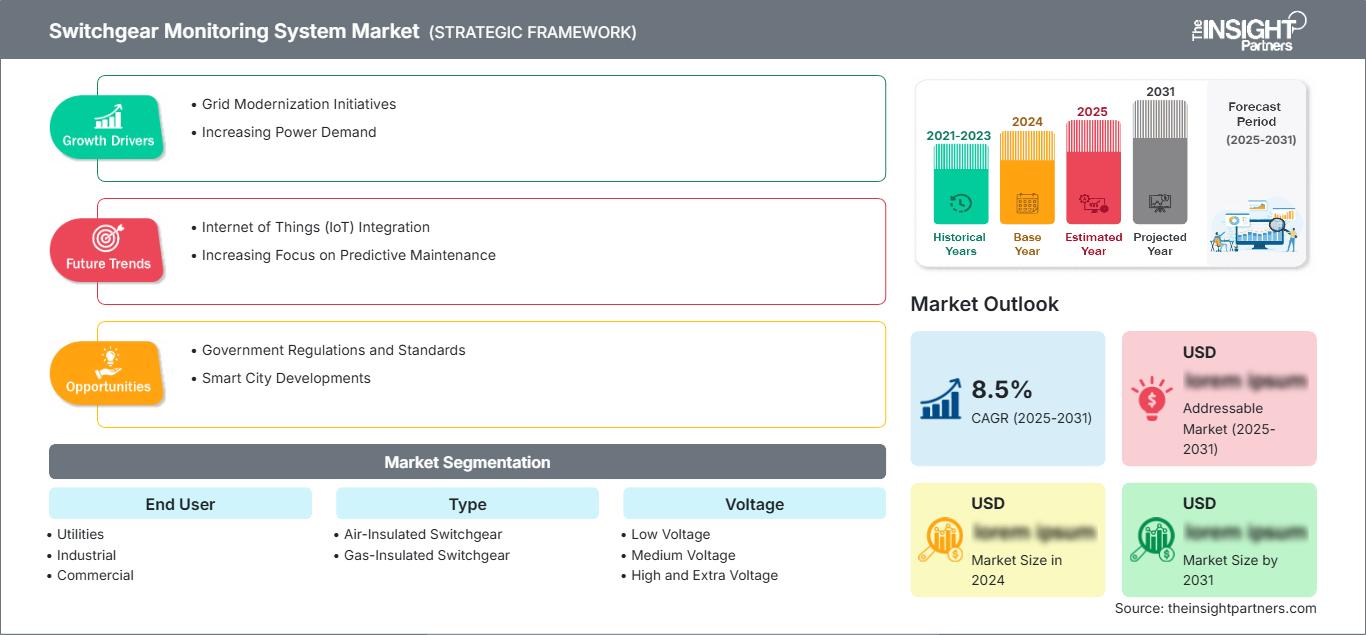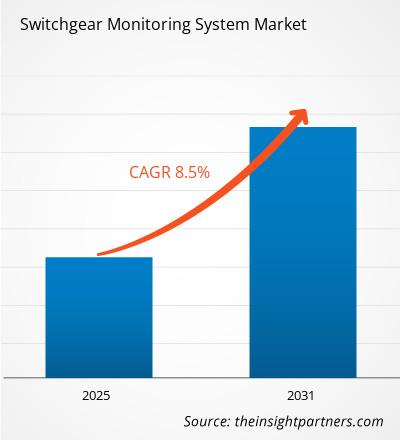The Switchgear Monitoring System Market is expected to register a CAGR of 8.5% from 2025 to 2031, with a market size expanding from US$ XX million in 2024 to US$ XX Million by 2031.
The report is segmented By End User (Utilities, Industrial, Commercial, Others), Type (Air-Insulated Switchgear, Gas-Insulated Switchgear), Voltage (Low Voltage, Medium Voltage, High and Extra Voltage). The global analysis is further broken-down at regional level and major countries. The report offers the value in USD for the above analysis and segments
Purpose of the Report
The report Switchgear Monitoring System Market by The Insight Partners aims to describe the present landscape and future growth, top driving factors, challenges, and opportunities. This will provide insights to various business stakeholders, such as:
- Technology Providers/Manufacturers: To understand the evolving market dynamics and know the potential growth opportunities, enabling them to make informed strategic decisions.
- Investors: To conduct a comprehensive trend analysis regarding the market growth rate, market financial projections, and opportunities that exist across the value chain.
- Regulatory bodies: To regulate policies and police activities in the market with the aim of minimizing abuse, preserving investor trust and confidence, and upholding the integrity and stability of the market.
Switchgear Monitoring System Market Segmentation
End User
- Utilities
- Industrial
- Commercial
- Others
Type
- Air-Insulated Switchgear
- Gas-Insulated Switchgear
Voltage
- Low Voltage
- Medium Voltage
- High and Extra Voltage
Geography
- North America
- Europe
- Asia-Pacific
- South and Central America
- Middle East and Africa
You will get customization on any report - free of charge - including parts of this report, or country-level analysis, Excel Data pack, as well as avail great offers and discounts for start-ups & universities
Switchgear Monitoring System Market: Strategic Insights

-
Get Top Key Market Trends of this report.This FREE sample will include data analysis, ranging from market trends to estimates and forecasts.
Switchgear Monitoring System Market Growth Drivers
- Grid Modernization Initiatives: The market for switchgear monitoring systems is expanding as a result of significant international investments in modernizing power infrastructure. In order to improve asset management, decrease downtime, increase grid reliability, and apply predictive maintenance techniques throughout transmission and distribution networks, electrical utilities are giving top priority to cutting-edge monitoring systems.
- Increasing Power Demand: Switchgear monitoring system usage is being driven by sophisticated power distribution requirements and rising electricity consumption. Sophisticated real-time monitoring systems that guarantee operational safety, maximize power management, and offer thorough insights into the functioning of electrical infrastructure are required by the commercial, residential, and industrial sectors.
Switchgear Monitoring System Market Future Trends
- Internet of Things (IoT) Integration: Switchgear monitoring systems are experiencing a transformative trend toward comprehensive IoT-enabled intelligent networks. Advanced sensor technologies, cloud connectivity, and predictive analytics enable real-time data collection, remote diagnostics, and proactive maintenance strategies across diverse electrical infrastructure environments.
- Increasing Focus on Predictive Maintenance: The trend of predictive maintenance is transforming the switchgear monitoring system market. By leveraging advanced data analytics, these systems can predict potential failures and suggest timely interventions. This approach minimizes downtime and maintenance costs, offering a significant advantage over traditional maintenance strategies, where failures are addressed reactively. Predictive maintenance is becoming a key focus for industries aiming to optimize asset lifespan and efficiency.
Switchgear Monitoring System Market Opportunities
- Government Regulations and Standards: Government regulations and safety standards are creating opportunities for switchgear monitoring systems. As countries implement stricter regulations on grid reliability, safety, and energy efficiency, industries and utilities are turning to monitoring systems to comply with these requirements. Governments worldwide are increasingly mandating advanced monitoring solutions to improve the safety and efficiency of electrical networks, driving market growth.
- Smart City Developments: The rapid growth of smart cities presents a growing opportunity for switchgear monitoring systems. These cities rely on advanced infrastructure to manage power distribution, water supply, and other critical utilities. As smart city projects expand globally, switchgear monitoring systems are becoming essential for ensuring the reliability, safety, and efficiency of electrical distribution networks within urban areas.
Switchgear Monitoring System Market Regional Insights
The regional trends and factors influencing the Switchgear Monitoring System Market throughout the forecast period have been thoroughly explained by the analysts at The Insight Partners. This section also discusses Switchgear Monitoring System Market segments and geography across North America, Europe, Asia Pacific, Middle East and Africa, and South and Central America.
Switchgear Monitoring System Market Report Scope
| Report Attribute | Details |
|---|---|
| Market size in 2024 | US$ XX million |
| Market Size by 2031 | US$ XX Million |
| Global CAGR (2025 - 2031) | 8.5% |
| Historical Data | 2021-2023 |
| Forecast period | 2025-2031 |
| Segments Covered |
By End User
|
| Regions and Countries Covered |
North America
|
| Market leaders and key company profiles |
|
Switchgear Monitoring System Market Players Density: Understanding Its Impact on Business Dynamics
The Switchgear Monitoring System Market is growing rapidly, driven by increasing end-user demand due to factors such as evolving consumer preferences, technological advancements, and greater awareness of the product's benefits. As demand rises, businesses are expanding their offerings, innovating to meet consumer needs, and capitalizing on emerging trends, which further fuels market growth.

- Get the Switchgear Monitoring System Market top key players overview
Key Selling Points
- Comprehensive Coverage: The report comprehensively covers the analysis of products, services, types, and end users of the Switchgear Monitoring System Market, providing a holistic landscape.
- Expert Analysis: The report is compiled based on the in-depth understanding of industry experts and analysts.
- Up-to-date Information: The report assures business relevance due to its coverage of recent information and data trends.
- Customization Options: This report can be customized to cater to specific client requirements and suit the business strategies aptly.
The research report on the Switchgear Monitoring System Market can, therefore, help spearhead the trail of decoding and understanding the industry scenario and growth prospects. Although there can be a few valid concerns, the overall benefits of this report tend to outweigh the disadvantages.
Frequently Asked Questions
What are the options available for the customization of this report?
What are the deliverable formats of the market report?
What are the future trends of the switchgear monitoring system market?
What are the driving factors impacting the global switchgear monitoring system market?
What is the expected CAGR of the switchgear monitoring system market
- Historical Analysis (2 Years), Base Year, Forecast (7 Years) with CAGR
- PEST and SWOT Analysis
- Market Size Value / Volume - Global, Regional, Country
- Industry and Competitive Landscape
- Excel Dataset
Recent Reports
Related Reports
Testimonials
Reason to Buy
- Informed Decision-Making
- Understanding Market Dynamics
- Competitive Analysis
- Identifying Emerging Markets
- Customer Insights
- Market Forecasts
- Risk Mitigation
- Boosting Operational Efficiency
- Strategic Planning
- Investment Justification
- Tracking Industry Innovations
- Aligning with Regulatory Trends





















 Get Free Sample For
Get Free Sample For